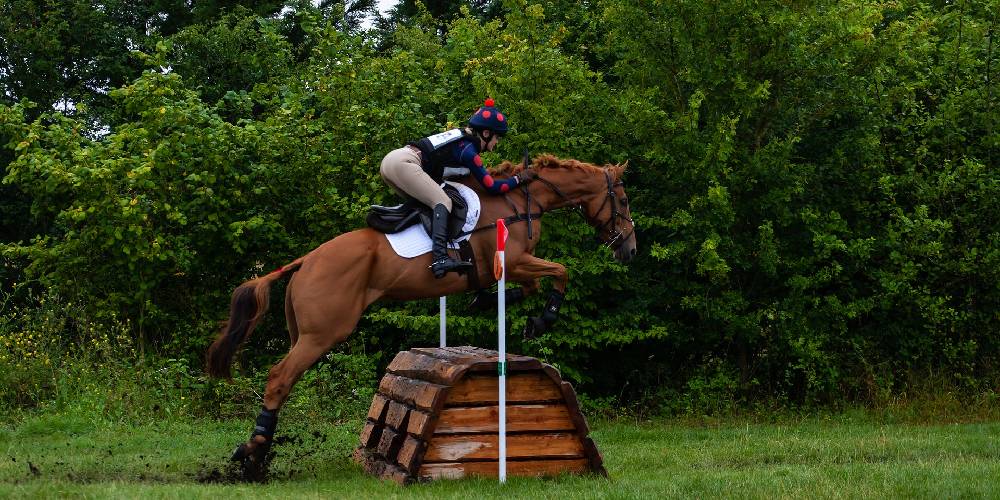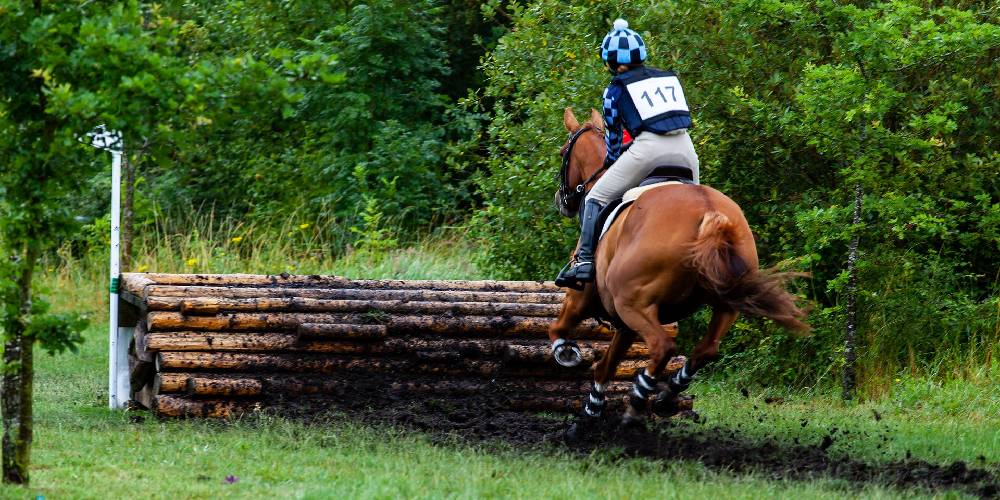If you ever look at a cross country course, you might see that there are tons of different jumps that you must clear. These jumps are often wide and look intimidating as they test your horse’s bravery and jumping ability. I made this guide in hopes to prepare any of you aspiring cross country and eventing riders out there for the jumps you might face on different courses.
1. Normandy Bank
A Normandy bank jump is a jump that makes the horse jump down rather than up. It is kind of like a sunken road jump where the horse jumps down off of a ledge and into a ditch instead of up over one. These jumps test the horse’s bravery and trust in the rider regardless of the horse’s poor depth perception.
2. Tiger Trap

A tiger trap jump is probably one of the only jumps on the cross country course that is similar to that of a jump found in a showjumping arena. This jump consists of poles like on a showjumping jump, only they are arranged in a triangular pattern causing the horse to jump further out than they would normally have to over a showjumping jump.
In these jumps, the size of the jump depends on the level of competition and how difficult the course is.
This style or design of jump is one of the most popularly seen in cross country.
Sometimes these jumps, as seen in the image above, don’t contain rails and instead are made up of planks, though the shape remains the same.
3. Corner Jump
Corner jumps are jumps that look really intimidating but are less so when you actually clear them. A corner jump is a large triangular shaped jump that can either be covered in brush or look more like a wooden platform. In these jumps there will usually be markers or stakes that show where the horse should jump over. These jumps only require the horse to jump over one corner of the platform which is why they are known as corner jumps.
4. Chevron Jump

A chevron jump is a jump that consists of two standards or anchoring posts of some sort, and a flat piece of material that leans against these posts. This causes the jump to be in a lean-to shape making the horse not only jump up but also out.
5. Log Jump

There are a variety of different types of log jumps. Some are in the shape of the tiger trap jump; a pile of logs that a horse needs to jump over. Other log jumps are just a log that a horse must jump over.
Some of the logs that a horse must clear are large which causes the horse to jump high and far to be able to clear them. Usually, the logs that these horses must clear are stripped of their branches and bark.
6. Key Hole
The keyhole jump is one of the most unique jumps on the cross-country course. This jump can be seen in a number of different shapes, sizes, and heights, but all of them share one thing in common, the fact that the horse must jump through a hole or gap of some sort.
This jump can be made from logs, hedges, or other materials depending on the cross country course.
7. Weldon’s Wall

The Weldon’s Wall jump is a jump that is basically, well, a wall. This jump is a small wall that the horse must clear. These jumps are usually made from wood and can be a variety of heights.
This jump is one of the more common jumps seen in a cross country course.
8. Coffin Jump
The coffin jump is also known as a ditch jump.
Coffin jumps are jumps that basically consist of a box that is pretty much set into the ground. Sometimes a coffin jump might be put in front of a jump to make the horse jump further and longer, or be put in between two jumps to create a combination jump.
These ditches can be anywhere from six inches deep to three feet deep depending on the course, the level of the competition, and the jumps.
The coffin jump gets its name because of its shape and design as it resembles a coffin or grave.
9. Sunken Road
A sunken road jump is a jump where a horse must jump down into a ‘road’ and up back out of it onto the other side after crossing it. This obstacle is often paired with other jumps both in the ‘road’ and back out of it.
10. Water Jumps

Though the horses on this course aren’t jumping over water, they are often jumping into it and out of it. Many jumps will be put into combination with water to test the horse’s bravery and confidence in their rider.

